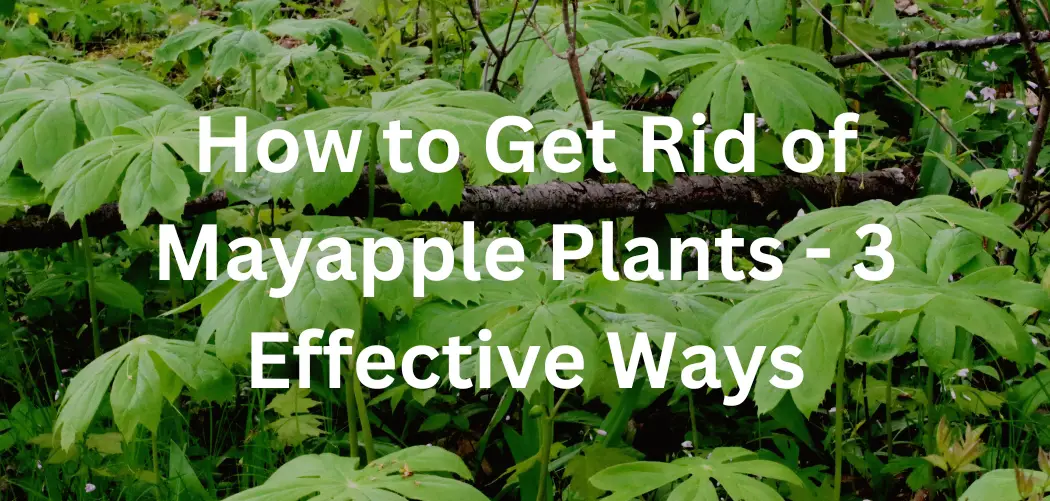We're an affiliate
We hope you love the products we recommend! Just so you know, we may collect a share of sales or other compensation from the links on this page. Thank you if you use our links, we really appreciate it!
Mayapple plants (Podophyllum peltatum) are native to North America and are known for their unique umbrella-like leaves and single white flower. While they can be aesthetically pleasing in natural woodland settings, they have the potential to become invasive and crowd out native vegetation. In this comprehensive guide, we will walk you through the process of effectively removing Mayapple plants to prevent their spread and protect the biodiversity of your garden or natural area.
Table of Contents
Understanding Mayapple Plants
Identification
Mayapple plants can reach a height of 12-18 inches (30-45 cm) and feature large, deeply lobed umbrella-shaped leaves. These leaves emerge in early spring and can completely cover the ground. In May, a single white flower blooms beneath the leaves, eventually developing into a yellow fruit. It’s important to note that while the fruits are toxic and should not be consumed, they serve as a dispersal mechanism for the plant.
Habitat and Growth Patterns
Mayapple plants thrive in moist, shaded woodland environments, particularly in areas with rich organic soil. They spread through rhizomes, which are underground stems that produce new shoots and roots. The rhizomes can form extensive colonies, making Mayapple plants difficult to control if left unattended.
Preparation
Safety Precautions: Before you embark on the removal process, it’s essential to prioritize safety. Wear protective clothing, including long sleeves, pants, gloves, and eye protection, to shield yourself from potential skin irritations caused by the plant’s sap.
Tools and Equipment: To successfully remove Mayapple plants, gather the following tools and equipment:
- Gardening gloves: Sturdy gloves will protect your hands from thorns, potential irritations, and any sharp tools you may use.
- Hand pruners or garden shears: These will be useful for cutting back the above-ground foliage.
- A shovel or garden fork: These tools will aid in digging around the plants to remove the rhizomes effectively.
Removal Methods
Manual Removal
- Start by locating the Mayapple plants in your garden or natural area.
- Grip the plant at the base, close to the soil, and gently pull upward, ensuring you remove the entire plant, including the root system.
- Inspect the surrounding soil for any remaining rhizomes and remove them carefully to prevent future growth.
Cutting and Digging
- For more established Mayapple plants or larger colonies, begin by cutting back the above-ground foliage as close to the soil as possible using hand pruners or garden shears.
- Use a shovel or garden fork to dig around the base of the plant, aiming to expose the rhizomes.
- Gradually remove the soil around the rhizomes, tracing their path and locating any connected shoots or roots.
- Once you’ve exposed the rhizome system, carefully remove the entire network, ensuring no pieces are left behind.
Herbicides
Herbicides should be used as a last resort for extensive or persistent Mayapple infestations. Always follow the manufacturer’s instructions and consider their environmental impact. If you decide to use herbicides:
- Choose a selective herbicide recommended for controlling Mayapple plants.
- Apply the herbicide according to the instructions, focusing on the foliage of the plants.
- Be cautious not to spray neighboring plants or desired vegetation.
- Repeat the application if necessary, adhering to the recommended timing for effective control.
Disposal
Proper Waste Disposal: To prevent the spread of Mayapple plants and ensure their complete eradication, it’s crucial to dispose of the plant debris properly.
- Collect the removed plants, including any severed rhizomes, into a bag or container.
- If possible, avoid composting the plants, as they may regenerate from discarded plant parts.
- Contact your local municipality to inquire about green waste disposal or consult local gardening experts for proper disposal methods.
Preventing Spread: To minimize the chances of Mayapple plants re-establishing or spreading:
- Thoroughly clean your tools and equipment after each removal session to prevent accidental transport of rhizome fragments.
- Regularly monitor the area for any signs of new Mayapple growth and promptly remove any emerging plants.
Prevention and Long-Term Management:
Site Maintenance: To prevent the recurrence of Mayapple plants and maintain a healthy ecosystem:
- Inspect your garden or natural area regularly, paying attention to areas where Mayapple plants have previously been present.
- Take immediate action to remove any new growth before it becomes established.
Native Plant Alternatives: Consider replacing Mayapple plants with native species that can provide similar aesthetic qualities and ecological benefits. Some alternatives may include:
- Wild ginger (Asarum spp.): This low-growing ground cover features heart-shaped leaves and thrives in shaded areas.
- Virginia bluebells (Mertensia virginica): These spring-blooming perennials boast beautiful blue flowers and tolerate partial shade.
Conclusion
By following these step-by-step instructions, you can effectively eliminate Mayapple plants from your garden or natural area. Remember to prioritize safety, be thorough in your removal efforts, and dispose of the plants properly. Regular maintenance and the introduction of native plant alternatives will help prevent Mayapple re-establishment and contribute to a thriving, diverse ecosystem.


